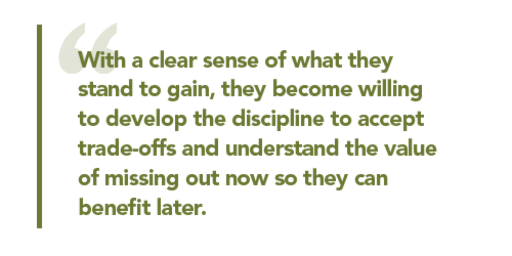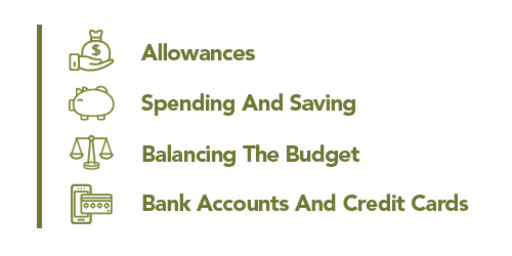It’s never too early to start helping kids understand the importance of financial literacy. Only about 60% of Class of 2020 high school graduates and 56% of teens who haven’t graduated have discussed family finances with a parent or guardian, according to a 2021 Junior Achievement Personal Finance Survey of teens ages 13-19. Children significantly affect how families manage their finances, and they will eventually have finances of their own to manage. Over time, their relationship to money changes, and with that change comes the need to learn new perspectives and develop fiscally responsible habits.
Principles Of Fiscal Responsibility
The first layer of teaching kids about money is to help them understand how your family uses it. Giving them some insight into your own relationship with finance can help them understand what’s realistic. This type of “crash course” in fiscal responsibility can lay the foundation for a lifetime of smart financial decisions.
Make Money Make Sense
While it’s obvious to adults what money is, it’s not necessarily obvious to kids. They may understand that money allows their parents to buy stuff but not get where it comes from, how goods and services are valued, or how to put it to work.
Especially in our digital age, so much of finance never appears in the “real” world. Debit cards, credit cards, and gift cards look more or less the same and you can’t tell how much is on them just by looking. And those are only the most basic of spending tools — mutual funds, the stock market, and other investment vehicles are completely foreign to most kids.
All of this makes it easy for kids to take money for granted. The first step toward fiscal responsibility is to explain how money works.
Talking Through Taboo
It is often considered taboo in western cultures to talk about money. Everyone’s approach is different, and situations and decisions are deeply personal. We worry that if we disclose the details of our financial situations, people negatively judge our work ethic, lifestyle, or value systems. We also have a tendency to compare ourselves to our peers, even though what we see is often different from the reality, and this can give people — kids especially — a misguided sense of how things are.
If no one is talking about money, lessons in financial literacy are hard to find. Relatively speaking, family units are safe places for conversations about finance. Inviting kids into the discussion early will help them get a real-world sense of the role of money in their lives, as well as teach them which issues are universal and which are subjective.

Wants Vs. Needs
A key component of financial literacy for kids is understanding the difference between the things we want and the things we need. Having a clear sense of urgency and proportion is essential when it comes to setting priorities that drive financial decisions both big and small. You can start with simple exercises with younger children or help teens make a budget with their allowance or income from their job to provide greater perspective on needs vs. wants.
Planning For The Future Today
The habits kids form today often last well into adulthood. Developing a healthy relationship with personal finance will pay dividends down the line, so it’s valuable to instill the idea that everything kids do today is an investment in the future.
Setting concrete goals — and making those goals visible (and the progress towards them) — can be very helpful. Vision boards for the whole family with pictures of what you want to buy or vacations you want to take make the abstract notion of “saving money” feel tangible.
Mindful visualization of how you want to spend your money also helps kids become conscientious consumers. With a clear sense of what they stand to gain, they become willing to develop the discipline to accept trade-offs and understand the value of missing out now so they can benefit later.
Financial Literacy For Kids 
With a strong conceptual foundation for fiscal responsibility, kids will be well positioned to learn how to actually manage their money. Not every aspect of finance is accessible to all ages, but children are likely to encounter all of them by early adulthood.
Allowances
Giving your child an allowance is a great method for teaching kids about money. A Harris Poll found that about two-thirds of parents give kids a weekly allowance, averaging about $30 a week. Experts recommend starting around age five or when they can count money, and not tying it to household duties, but using it for financial education. After all, fiscal responsibility is no more than a theory until they’re able to actually practice. Parents have several different approaches to choose from, and that choice should be guided by what’s appropriate for your family.
Regardless of which approach you choose, consider the following guidelines:
- Establish clear expectations. You can think about an allowance as a contract. Make sure your kid understands their end of the bargain as you decide on spending and saving parameters together.
- Set parameters. It may be appropriate to limit when, how, and what amount they can spend in a given period of time. Do they have to ask your permission before spending, or are they free to use (or misuse) their money as they please?
- Make it routine. Pay out allowances on a regular schedule to familiarize them with how compensation generally works in the adult world.
Spending And Saving
After they’ve earned a little money, they may be tempted to spend it all at once. However, a good tenet of fiscal responsibility is to maintain spending categories, such as the following:
- Essential spending for necessities like groceries and bills
- Recreational spending for things they want but don’t need
- Saving, whether targeted for a specific, high-dollar purpose or as an all-purpose safety net
- Investing to diversify their assets
- Donating to experience the value of giving back
Allocating income across multiple categories can help them more easily manage all aspects of financial stability as adults. Balancing The Budget It’s obvious — even to kids — that you can’t spend more than you have. But it takes a little practice to understand how far your money will take you. Projecting income and expenses into the future is an essential part of running a balanced budget. A spreadsheet can be very helpful here.
Kids also need guidance as they prioritize so they’re prepared to make informed decisions about whether, when, and how much to spend.
Bank Accounts And Credit Cards
A piggy bank is a fine place to start the savings process, but they’ll outgrow them. Eventually they’ll need a bank account to hold their money and a card that lets them use it. Now is the time to teach them some of the more advanced practicalities of money management — that different financial tools have different structures, requirements, and fees.
The same goes for credit cards. “Buy now, pay later” is easy to understand, but there are serious consequences if they overextend themselves. Teaching kids about money goes beyond dollars and cents. Interest rates, credit scores, and other realities loom large, and financial literacy for kids is incomplete without going over them.
Real-Life Ways To Engage Children In The Process
Incorporating fiscal responsibility into everyday life is important to reinforce the principals of personal financial management. When they are involved in practicing it throughout their lives in different situations, it becomes habit into adulthood. Here are a few examples from my own life of ways we involve our children in budgeting.
Birthday budgeting. The next time you’re planning a birthday party for your child, set a budget and allow your child to help plan the party. If they don’t use all the funds, allow them to keep the remainder or purchase something they’ve been wanting. Over the years, as our kids have been involved at this level, they have not only learned budgeting, but refocused their attention on what’s most important about their birthdays. It hasn’t been big parties, but rather time with their closest friends.
Budgeting during vacation. Beginning at age 4 or 5, we provided cash to each of our children for souvenirs in separate bank envelopes marked with their names. We allowed them to choose what they wanted with their funds, as long as it was age-appropriate and there were no safety concerns.
Back-to-school shopping. Now that our kids are teenagers, they have the flexibility to go school shopping on their own and have a budget. We give them a list of things that they must purchase within the budget, and again, if they don’t spend everything on school supplies, they get to keep or save the additional funds.
In our family, this is now translating into college discussions, as we have a high school junior. She understands the importance of college costs, the lifelong benefits of starting from a financial position of strength, and operating within a budget. I hope these three invaluable lessons serve her well as she plans out her college career in the coming years and continues into her adulthood.





